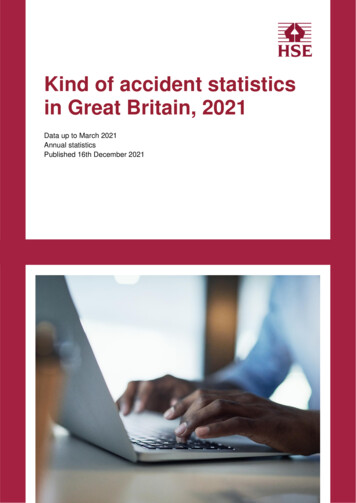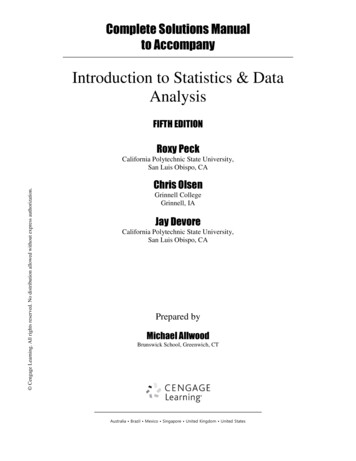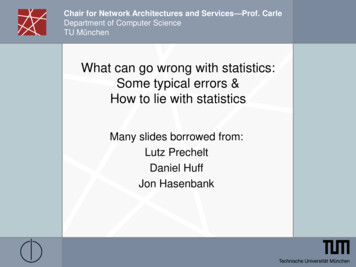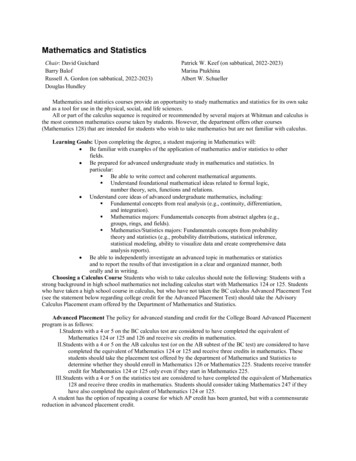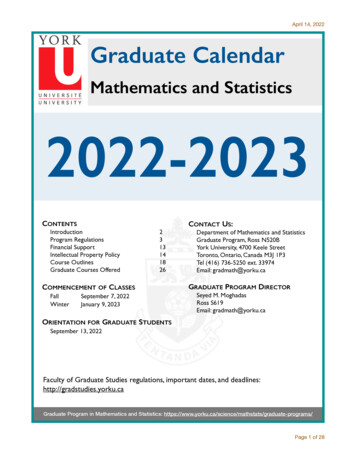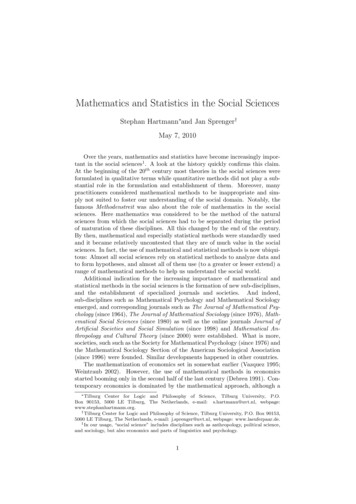
Transcription
Mathematics and Statistics in the Social SciencesStephan Hartmann and Jan Sprenger†May 7, 2010Over the years, mathematics and statistics have become increasingly important in the social sciences1 . A look at the history quickly confirms this claim.At the beginning of the 20th century most theories in the social sciences wereformulated in qualitative terms while quantitative methods did not play a substantial role in the formulation and establishment of them. Moreover, manypractitioners considered mathematical methods to be inappropriate and simply not suited to foster our understanding of the social domain. Notably, thefamous Methodenstreit was also about the role of mathematics in the socialsciences. Here mathematics was considered to be the method of the naturalsciences from which the social sciences had to be separated during the periodof maturation of these disciplines. All this changed by the end of the century.By then, mathematical and especially statistical methods were standardly usedand it became relatively uncontested that they are of much value in the socialsciences. In fact, the use of mathematical and statistical methods is now ubiquitous: Almost all social sciences rely on statistical methods to analyze data andto form hypotheses, and almost all of them use (to a greater or lesser extend) arange of mathematical methods to help us understand the social world.Additional indication for the increasing importance of mathematical andstatistical methods in the social sciences is the formation of new sub-disciplines,and the establishment of specialized journals and societies. And indeed,sub-disciplines such as Mathematical Psychology and Mathematical Sociologyemerged, and corresponding journals such as The Journal of Mathematical Psychology (since 1964), The Journal of Mathematical Sociology (since 1976), Mathematical Social Sciences (since 1980) as well as the online journals Journal ofArtificial Societies and Social Simulation (since 1998) and Mathematical Anthropology and Cultural Theory (since 2000) were established. What is more,societies, such such as the Society for Mathematical Psychology (since 1976) andthe Mathematical Sociology Section of the American Sociological Association(since 1996) were founded. Similar developments happened in other countries.The mathematization of economics set in somewhat earlier (Vazquez 1995;Weintraub 2002). However, the use of mathematical methods in economicsstarted booming only in the second half of the last century (Debreu 1991). Contemporary economics is dominated by the mathematical approach, although a Tilburg Center for Logic and Philosophy of Science, Tilburg University, P.O.Box 90153, 5000 LE Tilburg, The Netherlands, e-mail: s.hartmann@uvt.nl, webpage:www.stephanhartmann.org.† Tilburg Center for Logic and Philosophy of Science, Tilburg University, P.O. Box 90153,5000 LE Tilburg, The Netherlands, e-mail: j.sprenger@uvt.nl, webpage: www.laeuferpaar.de.1 In our usage, “social science” includes disciplines such as anthropology, political science,and sociology, but also economics and parts of linguistics and psychology.1
certain style of doing economics becomes more and more under attack in the lastdecade or so. Recent developments in behavioral economics and experimentaleconomics can also be understood as a reaction against the dominance (andlimitations) of an overly mathematical approach to economics. There are similar debates in other social sciences, but it is important to stress that problemsof one method (such as axiomatization or the use of set theory) can hardly betaken as a sign of bankruptcy of mathematical methods in the social sciencestout court.This chapter surveys mathematical and statistical methods used in the socialsciences and discusses some of their philosophical questions. It is divided intotwo parts. Sections 1 to 3 are devoted to mathematical methods, and Sections4 to 8 to statistical methods.1A Plurality of Mathematical MethodsSocial scientists use a wide variety of mathematical methods. Given that thespace of this chapter is restricted, it is impossible to list them all, give examples,examine their domain of applicability, and to discuss some of the philosophicalproblems they raise. Instead, we broadly distinguish between three differentkinds of methods: (i) methods imported from the formal sciences, (ii) methodsimported from the natural sciences, and (iii) sui generis social scientific methods.We review them in turn.Methods imported from the formal sciences include (linear) algebra, calculus (including differential equations), the axiomatic method, logic andset theory, probability theory (including Markov chains), linear programming,topology, graph theory, and complexity theory. All these methods have important applications in the social sciences.2 In recent years, various methods fromcomputer science have been incorporated into social science research as well.There is also a strong trend within computer science to address problems fromthe social sciences. An example is the recent establishment of the new interdisciplinary field Computational Social Choice which is dominated by computerscientists.3Interesting, though, much work in Computational Social Choice uses analytical and logical methods. There is, however, also a strong trend in the socialsciences to use powerful numerical and simulation methods to explore complexan (typically) dynamical social phenomena. The reason for this is of course theavailability of high-powered computers. But not all social scientists follow thistrend. Especially many economists are reluctant to use simulation methods anddo not consider them to be appropriate tools to study economic systems.4Methods imported from the natural sciences become more and morepopular in the social sciences. These methods are more specific than the formalmethods mentioned above; they involve substantial assumptions that happen –or so it is claimed – to be fulfilled in the social domain. These methods comprisetools to study multi-agent systems, the theory of complex systems, non-linear2 For a lucid exposition of many of these methods and examples from the social sciecnes,see Luce and Suppes (1968).3 See http://www.illc.uva.nl/COMSOC/4 For a discussion of computer simulations in the social sciences, see Hegselmann et al.(1996). In this context it is interesting to study the influence of the work done at the Santa FeInstitute on mainstream economics. See e.g. Anderson et al (1988). See also Waldrop (1992).2
dynamics, and the methods developed in synergetics (Weidlich 2006) and, morerecently, in econophysics (Mantegna and Stanley 1999). The applicability ofthese methods follows from the observation that societies are nothing but manybody systems (like a gas is a many-body system composed of molecules) thatexhibit certain features (such as the emergence of ordering phenomena). Hence,these features can be accounted for in terms of a statistical description, just likegases and other many-body systems which are studied in the natural sciences.Such methods are also used in new interdisciplinary fields such as environmentaleconomics.Besides providing various methods that can be used to study social phenomena, the natural sciences also inspired a certain way of addressing a problem.Meanwhile it is common to say that the core activity in the social sciences ismodel building.5 These models are carefully crafted, idealizations have to bemade, and the consequences of the model are often obtained with the help ofa computer simulation. This is much like in physics. Let us therefore call thisapproach the physicist’s approach to social science and contrast it with themathematician’s approach to social science outlined above.Finally, there are mathematical methods that emerged from problems in the social sciences. These include powerful instruments such asdecision theory6 , utility theory, game theory7 , measurement theory (Krantz etal. 1971), social choice theory (Gaertner 2006), and Judgment Aggregation(List and Puppe 2009). The latter theories were invented by social scientists,for social scientists and with a specific social-science application in mind. Theyhelp addressing specific problems that arise in the context of the social sciencesthat did not have an analogue in the natural sciences when they were invented.Only later, some of these theories also turned out to be useful in the naturalsciences or have been combined with insights from the natural sciences. Evolutionary game theory is a case in point.8 Other interesting examples are thestudy quantum games (Piotrowski and Sladkowski 2003) and the application ofdecision theory in fundamental physics (Wallace 2010).Interestingly, there are also methods that cannot be attached to one specificscience. Network theory is a case in point. As networks are studied in almost allsciences, parallel developments took place, and much can be learned by exploringwhat’s been obtained in other fields (Jackson 2008).9Having listed a large number of methods, the question arrises which methodis appropriate for a certain problem. This question can only be answered on acase by case basis and it is part of the ingenuity of the scientist to pick the bestmethod. But let us stress the following: While some scientists ask themselveswhich problems they can address with their favorite method, the starting pointshould always be a specific problem. And once a problem is chosen, the scientistpicks the best method that helps solving it. To have some choice, it is importantthat scientists are acquainted with as many methods as possible. Mathematics(and related disciplines) provide the scientist with a toolbox out of which they5 For a more detailed discussion of modeling in the social sciences, see ch. 29 (“Localmodels versus global theories, and their assessment”) of this handbook. For a general reviewof models in science, see Frigg and Hartmann (2007).6 See ch. 15 (“Rational choice and its alternatives”) of this handbook.7 See ch. 16 (“Game theory”) of this handbook.8 See ch. 17 (“Evolutionary approaches”) of this handbook.9 See also ch. 18 (“Networks”) of this handbook.3
have to pick a tool. Let us call this the Toolbox View.2Why Mathematizing the Social Sciences?A historically important reason for the mathematization of the social scienceswas that ‘mathematics’ is associated with precision and objectivity. These are(arguably) two requirements any science should satisfy, and so the mathematization of the social sciences was considered to be a crucial step that had tobe taken to turn the social sciences into real science. Some such view has beendefended by many authors. Luce and Suppes (1968), for example, argue alongthese lines for the importance of axiomatizing the theories of the social sciences.These authors also developed measurement theory (Krantz et al. 1971) andSuppes (1967, 2001) showed how the relation between a theory and its targetsystem can be explicated in mathematical terms. Contrary to this tradition, ithas been argued that the subject matter of the social sciences does not requirea high level of precision and that the social sciences are and should rather beinexact (cf. Hausman 1992). After all, what works in the natural sciences maywell not work in the social sciences.While Sir Karl Popper, one of the towering figures in the methodology ofsocial science, did not promote the mathematization of the social sciences inthe first place (Hands 2008), it is clear that it nevertheless plays an enormousrole in his philosophy. Given his focus on predictions and falsifiability, a theorythat is mathematized is preferable to a theory that is not. After all, it is mucheasier to derive falsifiable conclusions from clearly stated propositions than fromvague and informal claims.It is a mistake, however, to overestimate the role of the mathematics. Atthe end, mathematics provides the social scientist only with tools, and what oneobtains when using these tools will crucially depend on the assumptions thatare made. This is a variant of the well known GIGO principle from computerscience (“garbage in, garbage out). All assumptions are motivated informally;formulating them in the language of mathematics just helps putting them moreprecisely. And once the assumptions are formulated mathematically, the machinery of mathematics helps to draw inferences in an automated way. Thisholds for analytical calculations as well as for numerical studies, including computer simulations (Frigg and Reiss 2010; Hartmann 1996).This brings us to another advantage of mathematical methods in the socialsciences. While non-formal theories often remain rather simplistic and highlyidealized, formal theories can be complicated and (more) realistic, reflecting themessiness of our world. The mathematical machinery then helps drawing inferences which could not be obtained without them (Humphreys 2004). Oftendifferent assumptions pull in opposite directions, and it is not clear which onewill be stronger in a specific situation. However, when implemented in a mathematical model, it can be derived what happens in which part of the parameterspace. And so the availability of powerful computers allows the systematic studyof more realistic models.There is, however, also a danger associated with this apparent advantage.Given the availability of powerful computers, scientists may be tempted to construct very complex models. But while these models may do well in terms ofempirical adequacy, it is not so clear that they also provide understanding. This4
is often provided by rather simple models (sometimes called ‘toy models‘), i.e.models that pick only one crucial aspect of a system and help us to get a feelfor what follows from it.10There are several other reasons for the mathematization in the social sciences. We list them in turn.1. Theory Representation. Mathematics is used to formulate a theory.By doing so, the structure of the theory becomes transparent and therelationships that hold between the variables can be determined. Mathematics provides clarity, generality, and rigor. There are many ways torepresent a theory. For long, philosophers have championed the syntacticview (basically a representation of the theory in first order logic) or thesemantic view in its various forms (Balzer et al 1987; Suppes 2000). Whilethese reconstructions may be helpful for coming up with a consistent version of a theory, it apparently suffices for all practical purposes to state aset of equations that constitute the mathematical part of the theory.2. Theory Exploration. Once the theory is represented in mathematicalterms, the mathematical machinery can be employed to derive qualitativeand quantitative consequences of the theory. This helps to better understand what the theory is all about and what it entails about the world.The deductive consequences of the theory (and additional assumptionsthat have to be made) can be divided into retrodictions or predictions.For retrodictions the question arises which additional assumptions haveto be made to obtain a certain (already measured) value of a variable.3. Theory Testing. The predictions of a mathematically formulated theorycan then be used to test the theory by confronting its consequences withrelevant data. At the end, the theory will be confirmed or disconfirmed,or to put in Popperian terms, corroborated or falsified.4. Heuristics. Once the structure of a theory is formulated in mathematical term, a look at it may reveal analogies to other phenomena. Thismay inspire additional investigations (“intuition pump”) and lead to abetter understanding of the class of phenomena under investigation. Also,a numerical study of a theory may suggest new patterns that can be incorporated into the assumptions of another theory. A good example of thispoint is the use of cellular automata for studying the emergence of ordering phenomena, such as in Schelling’s famous Segregation Model (Sugden2008).5. Explanation and Understanding: While it is controversial what ascientific explanation is, it is clear that – once the theory is formulatedmathematically – a phenomenon can be fitting into a larger theoreticalpattern (as the unification account demands) or a causal story can beread off from the theory.10 For more doubts about some of the uses of simulations in the social sciences, seeHumphreys (2004).5
3Methodological IssuesThere are interesting parallels between the use of mathematics in the naturaland social sciences. In both kinds of sciences, we find a plurality of methodsranging from axiomatic methods to the use of computer simulations. We alsofind very different types of models, ranging from toy models (that illuminate onefeature of a system in a simple way without scoring high in terms of empiricaladequacy) to models that fit a large amount of data (but do not provide muchunderstanding). The mathematization also has similar purposes in both kindsof sciences: it helps to represent a certain object or system, to explain it and tomake predictions to test the underlying theory or model.However, there is also an interesting difference. This difference has to dowith the relation between the mathematical formalism and the data in the natural and social sciences. Let us assume that we have constructed a mathematicalmodel and we confront it with data. If the data correspond to what the modelpredicts, the model is confirmed. If the data contradict the model’s prediction,then there are two options in the natural sciences: either there was a measurement error, or (or an error can be excluded) the model has a problem. Thesetwo possibilities also show up in many social-science contexts. However, thereis a third option in the social sciences which has to do with the observation thatthe data in the social sciences are often not very hard.Let us give an example from cognitive psychology. In a series of experiments,Tversky and Kahneman (1983) showed that the participants commit fallaciessuch as the conjunction fallacy. In that case, 85% of the participants judge theconjunction of two propositions to be more probable than on the the conjuncts.One option to argue is that these people are irrational as they violate a basicrules of probability. However, things are not that easy. In the sequel, many otherexperiments were conducted and proposals were made as to how people reasonin such cases. What results is an intricate interplay between mathematicalmodeling and experimentation which does not occur in this form in the naturalsciences (Hertwig et al 2008; Hartmann and Meijs 2010).The softness of the data is probably also one of the reasons why there ismuch more debate in the social sciences about the usefulness of mathematicalmethods. The social sciences exhibit a wealth of of different approaches, andmathematical methods play a more or less important role in them. The defenders of mathematical methods will argue that mathematics simply providesa host of structures, and as the social world is structured just like the naturalworld is, some of these structures will fit (or approximately fit). Opponents willeither doubt that there are stable structures to be found in the social world,or they will argue that the structures that mathematics (and related sciences)provide do not fit as the social world is very different from the natural world.We take this to be an empirical question and do not see a reason why one shouldnot examine go ahead and employ mathematics in the social sciences.Besides the general debate about the usefulness of mathematical methodsin the social sciences, there is also a lot of debate about the question whichmethods are most appropriate. An example is the debate about econophysics.The practitioners of this field (mostly physicists or social scientists with a background in physics) approach certain problems from economics with the toolsof statistical physics. Typical results are the explanation of certain power lawsthat show up in economical data. But while concepts and ideas from physics6
have played an important role in economics in the past11 , many economistsdo not consider the explanations given by econophysicists as appropriate, cf.Gallegatti (2006).The above mentioned example from cognitive psychology suggests, however,that the standards for the assessment of mathematical approaches to the socialsciences are much less clear than in the natural sciences. One may reasonablydoubt the use of mathematical models altogether, and one may also doubt theapplication of a specific method. Much more needs to be done here until aconsensus (if there will ever be one) is reached.4The Development of Statistical ReasoningStatistical reasoning is nowadays a central method of the social sciences. First,it is indispensable for evaluating experimental data e.g. in behavioral economicsor experimental psychology. For instance, psychologists might want to find outwhether men act, in a certain situation, differently from women, or whetherthere are causal relationships between violent video games and aggressive behavior. Second, the social sciences heavily use statistical models as a modelingtool for analyzing empirical data and predicting future events, especially ineconometrics and operational research, but recently, also in the mathematicalbranches of psychology, sociology, and the like. For example, time series andregression models relate a number of input (potential predictor) variables tooutput (predicted) variables. Sophisticated model comparison procedures tryto elicit the structure of the data-generating process, eliminate some variablesfrom the model, select a “best model” and finally fit the parameter values tothe data.Still, the conception of statistics as an inferential tool is quite young:throughout the 19th century, statistics was mainly used as a descriptive toolto summarize data and to fit models. While in inferential statistics, the focuslies on testing scientific hypotheses against each other, or quantifying evidencefor or against a certain hypothesis, descriptive statistics focuses on summarizingdata and fitting the parameters of a given model to a set of data. The mostfamous example is maybe Gauß’ method of the least squares, a procedure tocenter a data set (xn , yn )n N around a straight line. Other important descriptive statistics are contingency tables, effect sizes, and tendency and dispersionmeasures.Descriptive statistics were, however, “statistics without probability” (Morgan 1987), or as one might also say, statistics without uncertainty. In thelate 19th and early 20th century, science was believed to be concerned withcertainty, with the discovery of invariable, universal laws. This left no placefor uncertain reasoning. Recall that at that time, stochastic theories in thenatural sciences, such as statistical mechanics, quantum physics, or laws of inheritance, were still quite new or not yet invented. Furthermore, there wasa hope of reducing them to more fundamental, deterministic regularities, e.g.to take the stochastic nature of statistical mechanics as an expression of ourimperfect knowledge, our uncertainty, and not as the fundamental regularitiesthat govern the motion of molecules. Thus, statistical modeling contradicted11 Examples are the work of the Physiocrats and the introduction of the concept of equilibrium, see Mirrowki (1889).7
the nomothetic ideal (Gigerenzer 1987), inspired by Newtonian and Laplaceanphysics, of establishing universal laws. Therefore statistics was considered asa mere auxiliary, imperfect device, a mere surrogate for proof by deduction orexperiment. For instance, the famous analysis of variance (ANOVA) obtainedits justification in the nomothetic view through its role in causal inference andelucidating causal laws.It is interesting to note that these views were held even in the social sciences,although the latter dealt with a reality that was usually too complex to isolatecausal factors in laboratory experiments. Controlling for external impacts andconfounders poses special problems to the social sciences, whose domain arehumans and not inanimate objects. The search for deterministic, universal lawsin the social sciences might thus seem futile – and this is probably the receivedview today –, but in the first half of the 20th century many social scientiststhought differently. Statistics was needed to account for measurement errorsand omitted causal influences in a model, but it was thought to play a merelyprovisional role:“statistical devices are to be valued according to their efficacy inenabling us to lay bare the true relationship between the phenomenaunder consideration. An ideal method would eliminate all of thedisturbing factors.” (Schultz 1928, 33)Thus, the view of statistics was eliminativist: as soon as it has done the joband elucidated the laws which we aim at, we can dismiss it. In other words,the research project consisted in eliminating probabilistic elements, instead ofdiscovering statistical laws and regularities or modeling physical quantities asprobabilistic variables with a certain distribution. This methodological presumption, taken from 19th century physics, continued to haunt social sciencesfar into the first half of the 20th century. Economics, as the “physics of socialsciences”, was particularly affected by that conception (Morgan 2002).In total, there are three main reasons why inferential statistics was recognized as a central method of the social sciences:1. The advances in mathematical probability, as summarized in the seminalwork of Kolmogorov (1933/56).2. The inferential character of many scientific questions, e.g. whether thereis a causal relationship between variables X and Y . There was a need fortechniques of data analysis that ended up with an inference or a decision,rather than with a description of a correlation.3. The groundbreaking works by particular pioneer minds, such as Tinbergenand Haavelmo in economics (Morgan 1987).The following sections investigate the different ways inferential statistics hasbeen spelled out, with a focus on the school that is most prominent in modernsocial science: Fisher’s method of significance testing.8
5Significance Tests and Statistical DecisionRulesOne of the great conceptual inventions of the founding fathers of inferentialstatistics was the sampling distribution (e.g. Fisher 1935). In the traditionalapproach (e.g. in classical regression), there was no need for the concept of asample drawn from a larger population – instead, the modeling process directlylinked the observed data to a probabilistic model. In the modern understanding,the actual data are just a sample drawn out of a much larger, hypothetical population about which we want to make an inference. The rationale for this viewof data consists in the idea that scientific results need to be replicable. Therefore, we have to make an inference about the comprehensive population (or thedata-generating process, for that matter) instead of making an ‘in-sample’ inference whose validity is restricted to the particular data we observed. This ideaof a sampling distribution proved crucial for what is known today as frequentiststatistics. That approach strongly relies about this idea of the sampling distribution, outlined in the seminal works of Fisher (1925, 1935, 1956) and Neymanand Pearson (1933, 1967), parting ways with the classical accounts of Bayes,Laplace, Venn and others.In frequentist statistics, there is a sharp division between approaches thatfocus on inductive behavior, such as the Neyman-Pearson school, and thosethat focus on inductive inference, such as Fisherian statistics. To elucidatethe difference, we will present both approaches in a nutshell. Neyman andPearson (1933) developed a behavioral framework for deciding between twocompeting hypotheses. For instance, take the hypothesis H0 that a certainlearning device does not improve the students’ performance, and compare itto the hypothesis H1 that there is such an effect. The outcome of the testis interpreted as a judgment on the hypothesis, or the prescription to take acertain action (“accept/reject H0 ”). They contrast two hypotheses H0 and H1and develop testing procedures such that the probability of erroneously rejectingH0 in favor of H1 is bounded at a certain level α, and that the probability oferroneously rejecting H1 in favor of H0 is, given that constraint, as low aspossible. In other words, Neyman and Pearson aim at maximizing power ofa test (the chance of a correct decision for H1 ) under the condition that thelevel of the test (the chance of an incorrect decision for H1 ) is bounded at areal number α. Thus, they developed a more or less symmetric framework formaking a decision between competing hypothesis, with the aim of minimizingthe chance of a wrong decision.While such testing procedures apply well to issues of quality control in industrial manufacturing and the like, the famous biologist and statistician RonaldA. Fisher (1935, 1956) argued that they are not suitable for the use in science.First, a proper behavioristic, or decision-theoretic approach has to determinecosts for faulty decisions (and Neyman-Pearson do this implicitly, by choosingthe level α of a test). This involves, however, reference to the purposes to whichwe want to put our newly acquired knowledge. For Fisher, this is not compatiblewith the idea of science as pursuit of truth. Statistical inference has to be “convincing to all freely reasoning minds, entirely independently of any intentionsthat might be furthered by utilizing the knowledge inferred” (Fisher 1956, 103).Second, in science, a judgment on the truth of a hypothesis is usually not made9
on the basis of a single experiment. Instead, we obtain some provisional resultwhich is refined through further analysis. By their behavioral rationale and bymaking a “decision” between two hypotheses, Neyman and Pearson insinuatethat the actual data justify a judgment on w
a high level of precision and that the social sciences are and should rather be inexact (cf. Hausman 1992). After all, what works in the natural sciences may well not work in the social sciences. While Sir Karl Popper, one of the towering gures in the methodology of social science, did not promote the mathematization of the social sciences in





